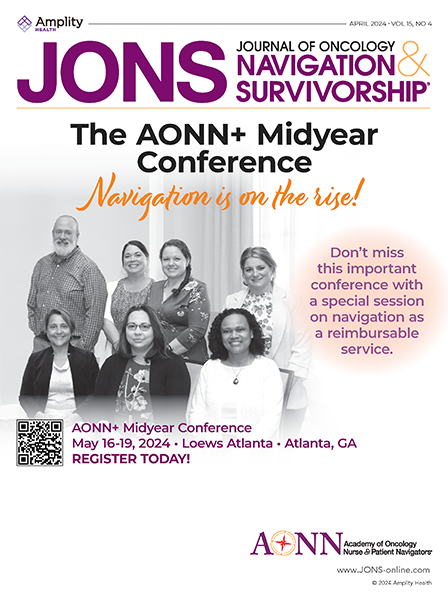Background: Tools that help to characterize patient acuity have been used in healthcare for decades and have proved successful as a means of determining staffing needs, improving patient care, and controlling costs.1 Time required by patients, as well as each barrier identified, predicted an increase in navigation intensity.2 Oncology patient navigation acuity is defined as a measure of patient distress, medical and psychosocial barriers, complexity of illness, and social determinants that indicate the need for the intensity of the subsequent navigator intervention.
Objectives: The aim is to develop, standardize, validate, and implement an evidence-based oncology patient navigation-specific acuity tool that will analyze and characterize the intensity of navigation workload to answer the basic question of how many patients a navigator can follow.3 The tool has the potential to aid administrators in the allocation of navigation resources and measure the effectiveness of navigation on patient outcomes.
Methods: In collaboration with Astellas, the Academy of Oncology Nurse & Patient Navigators (AONN+) Acuity Team examined the known navigation acuity scales found in the literature to provide a framework for the development of a standardized acuity measurement incorporating navigation core competencies, national oncology standards, and the AONN+ navigation metrics. A comprehensive search of the published literature related to patient acuity in the past 10 years was conducted. The search yielded 1711 articles, and, after screening for relevance, 105 were identified for inclusion.4 The review addressed the following research questions to reveal supporting attributes of navigation acuity:
- What are the definitions of acuity, acuity tool, acuity system, barriers to care, and distress?
- How can barriers to care be categorized?
- Is there a relationship between barriers to care and acuity?
- Is there a relationship between distress and acuity?
- What acuity tools already exist?
- How can a patient acuity score relate to factors such as productivity, return on investment, staffing/caseload, effectiveness, and time management?
- Is there any support in the literature to demonstrate that any of the AONN+ Standardized Metrics are patient acuity measures?
Results: Findings from the review and analysis of relevant articles, using the PRISMA model, indicate a high level of variability and complexity in how acuity and its related factors are defined and determined. The relationships between barriers to care and acuity and between distress and acuity regarding navigation have not been clearly established. Existing acuity tools present limitations in their application to an oncology patient navigation–specific tool.
Conclusion: The outcomes from the literature review and identified gaps were initial steps in helping the AONN+ Acuity Team to develop an oncology patient navigation–specific acuity tool. The work continues with correlating distress and barriers through key stakeholder feedback collected from randomized focus groups representing a variety of patient navigator roles so that a consensus definition of navigation acuity and categorization of barriers can be established using the practice-based opinions of navigators. Once developed, the standardized tool will be tested for reliability and validity. The vision continues that it will be used to help oncology navigators optimize the productivity of navigator programs as well as support and enhance oncology navigators’ effectiveness through patient-centric evidence-based methods.
Disclosures: Wendy Latash, PhD, is an employee of Astellas US, LLC.
References
- O’Keeffe M. Acuity-adjusted staffing: a proven strategy to optimize patient care. American Nurse Today. 2016;11(3):28-34.
- Carroll JK, Winters PC, Purnell JQ, et al. Do navigators’ estimates of navigation intensity predict navigation time for cancer care? J Cancer Educ. 2011;26:761-766.
- Shockney L. Insights into Navigation: Too Many Patients and Not Enough Time. https://aonnonline.org/expert-commentary/navigation-and-survivorship-news/596-insights-into-navigation-too-many-patients-and-not-enough-time.
- Johnston D, Gentry S, Strusowski T. Key considerations for an evidence-based oncology patient navigation–specific acuity tool: a scoping review. Journal of Oncology Navigation & Survivorship. 2019;10(7):274-284.






